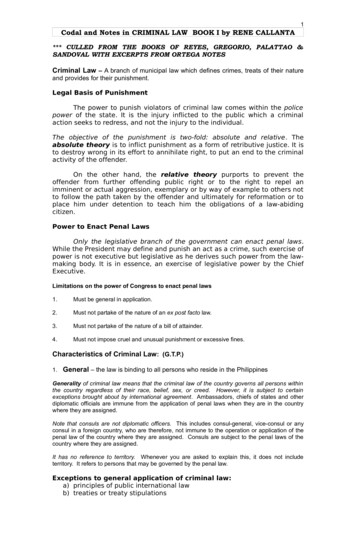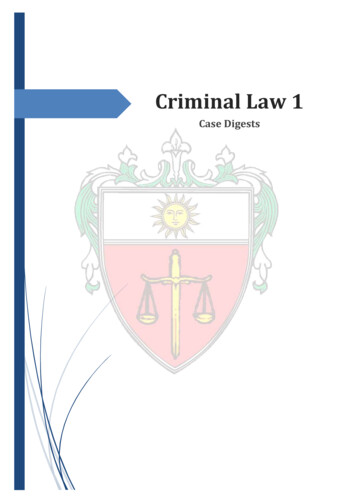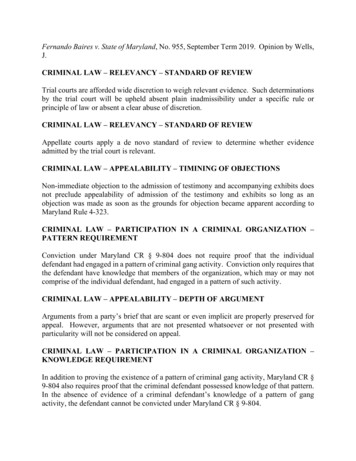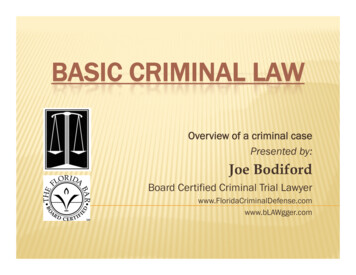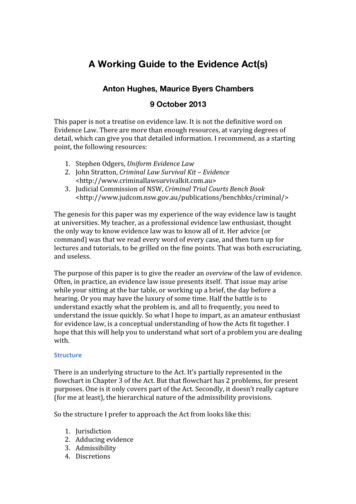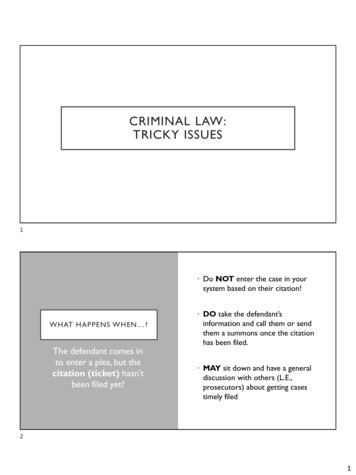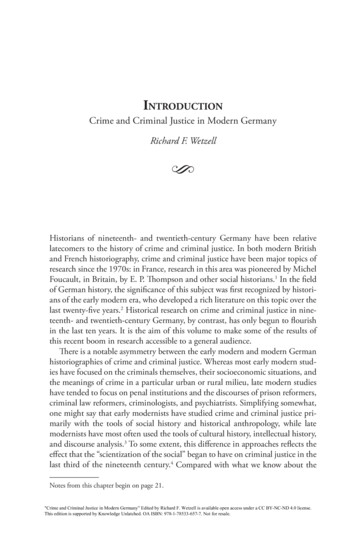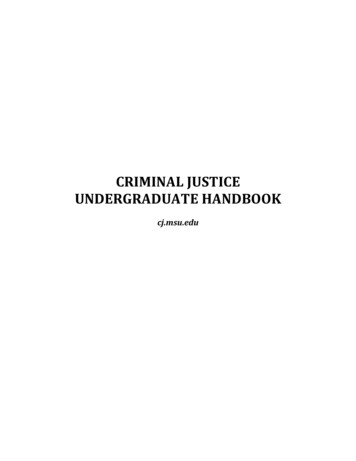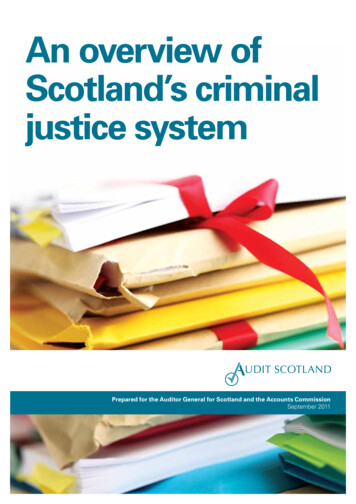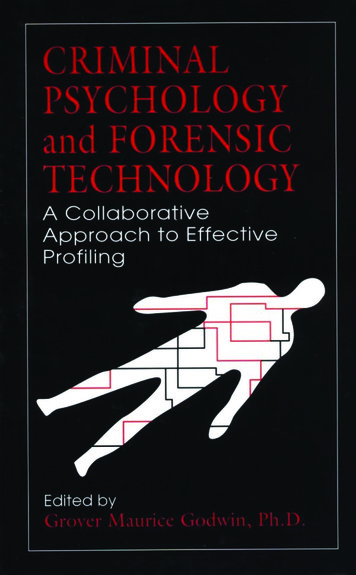
Transcription
CRIMINALPSYCHOLOGYand FORENSICTECHNOLOGYA CollaborativeApproach to EffectiveProfilingEdited byGrover Maurice Godwin, Ph.D.Research Assistant ProfessorJustice CenterThe University of Alaska –AnchorageCRC PressBoca Raton London New York Washington, D.C. 2001 CRC Press LLC
Front Cover: Helen M. GodwinLibrary of Congress Cataloging-in-Publication DataCriminal psychology and forensic technology : a collaborative approach to effectiveprofiling / editor, Maurice Godwin.p. cm.Includes bibliographical references and index.ISBN 0-8493-2358-41. Criminal psychology. 2. Forensic sciences. I. Godwin, Maurice.HV6080 .C734 2000364.3—dc2100-064150CIPThis book contains information obtained from authentic and highly regarded sources. Reprinted materialis quoted with permission, and sources are indicated. A wide variety of references are listed. Reasonableefforts have been made to publish reliable data and information, but the author and the publisher cannotassume responsibility for the validity of all materials or for the consequences of their use.Neither this book nor any part may be reproduced or transmitted in any form or by any means, electronicor mechanical, including photocopying, microfilming, and recording, or by any information storage orretrieval system, without prior permission in writing from the publisher.All rights reserved. Authorization to photocopy items for internal or personal use, or the personal orinternal use of specific clients, may be granted by CRC Press LLC, provided that .50 per page photocopiedis paid directly to Copyright Clearance Center, 222 Rosewood Drive, Danvers, MA 01923 USA. The feecode for users of the Transactional Reporting Service is ISBN 0-8493-2358-4/01/ 0.00 .50. The fee issubject to change without notice. For organizations that have been granted a photocopy license by theCCC, a separate system of payment has been arranged.The consent of CRC Press LLC does not extend to copying for general distribution, for promotion, forcreating new works, or for resale. Specific permission must be obtained in writing from CRC Press LLCfor such copying.Direct all inquiries to CRC Press LLC, 2000 N.W. Corporate Blvd., Boca Raton, Florida 33431.Trademark Notice: Product or corporate names may be trademarks or registered trademarks, and areused only for identification and explanation, without intent to infringe. 2001 by CRC Press LLCNo claim to original U.S. Government worksInternational Standard Book Number 0-8493-2358-4Library of Congress Card Number 00-064150Printed in the United States of America 1 2 3 4 5 6 7 8 9 0Printed on acid-free paper
PrefaceCriminal psychology, forensic technology, and profiling. These three disciplineshave received a wealth of media attention over the past decade. Consequently,due to public and professional interest, a plethora of books have been published.The technique of offender profiling, or classifying offenders according to theirbehaviors and characteristics, has been developing slowly as a possible investigative tool since 1841 and the publication of the The Murders in the Rue Morgueby Edgar Alan Poe, in which detective C. Auguste Dupin demonstrated theability to follow the thought patterns of a companion while the pair strolledthrough Paris without speaking a word. Some years later, the art of using psychology to profile a criminal was used in 1888 in England, where Dr. ThomasBond, a lecturer in forensic medicine, produced what could be recognized as apsychological profile of the perpetrator of the Whitechapel murders. Dr. Bondwrote to the head of the Criminal Investigation Division (Rumbelow, 1987:140):The murderer must have been a man of physical strength and great coolnessand daring. There is no evidence that he had an accomplice. He must, in myopinion, be a man subject to periodic attacks of Homicidal and erotic mania.The character of the mutilations indicates that the man may be in a conditionsexually, that may be called Satyriasis. It is of course possible that the Homicidal impulse may have developed from a revengeful or brooding conditionof mind, or that religious mania may have been the original disease, but I donot think that either hypothesis is likely. The murderer in external appearanceis quite likely to be a quite inoffensive looking man probably middle-age andneatly and respectable dressed. I think he might be in the habit of wearing acloak or overcoat or he could hardly escape notice in the streets if the bloodon his hands or clothes were visible.Assuming the murderer to be such a person as I have just described, he wouldbe solitary and eccentric in his habits. Also, he is likely to be a man withoutregular occupation, but with some small income or pension. He is possiblyliving among respectable persons who have some knowledge of his characterand habits who have grounds for suspicion that he is not quite right in hismind at times. Such person would probably be unwilling to communicateand would be suspicious of the police for fear of trouble or notoriety, whereasif there were prospects of a reward it might overcome his scruples. 2001 CRC Press LLC
Dr. Bond based his profile only on his professional experience, yet the claimshe made would probably be accepted as thoughtful and intelligent by mostpolice investigators today.Since its emergence, offender profiling has been described by several different terms: psychological profiling, criminal profiling, criminal personalityprofiling, and criminal investigative analysis. Regardless of the descriptive labelapplied, profiling as an investigative tool today represents a less–than–educatedattempt to provide law enforcement agencies with detailed information aboutthe behavior of an unknown individual who has committed a crime. Mostpublished accounts of profiling, which detail the methods employed by variousindividuals, have tended to take the form of semi-autobiographical books andjournalistic articles rather than systematic academic work and, hence, aredifficult to evaluate for accuracy or a scientific point of view. For example,most offender profiles emphasize the various psychological functions thatmurder has for the offender — not what varieties of action the murder actuallyconsists of. Consequently, these profiles make little distinction between theovert crime scene behavior as it occurs in murders and the psychodynamicprocesses that produce that behavior. Hence, there is little attempt by profilersto differentiate aspects of the offender’s motivations and life-style from aspectsof his offending behavior.Heuristics and Biases in Decision MakingAside from a few studies (e.g., Hunting Serial Predators, Godwin, 2000), mostpublished accounts that claim new findings in criminal profiling or serialoffending are often a part of the cultural baggage passed down over the years,and are fraught with the frailties of human thinking. Conclusions are predominantly based on what has been written in the past. For example, someprofilers claim that patterns associated with serial offending occur as a resultof recognizable mental illness or mental disorder in the offender, and thesedisorders can be classified using a personality theory. However, psychologicaltheory should never be treated as a vocabulary by so-called profilers or expertconsultants to further their personal opinions, rather than a set of empiricallyderived hypotheses open to scientific analysis. For instance, in a newspaperarticle about Robert Yates, a serial murderer recently captured in Spokane,Washington, a former homicide investigator, stated that the Yates case demonstrated that serial killers are individuals whose behavior cannot be predicted, yet a recently published journal article written by the investigatordescribes a theoretical typology by which sexual murderers’ motivations areprofiled. This is just one of the ways in which individuals attempt to blur thefacts when it comes to taking responsibility for inaccurate profiles and thefailure to link unsolved crimes. 2001 CRC Press LLC
Confirmation BiasNumerous studies have demonstrated that people generally give excessivevalue to confirmatory information; that is, information which supports aparticular position (Schwenk, 1988). Confirmation bias refers to a type ofselective thinking whereby one tends to look for what confirms one’s beliefs,and ignore or undervalue the relevance of contradictory information. Thistype of thinking results from deductive inferencing without supportinginductive research. For example, Wiseman, West, and Stemman (1996) foundthat in cases where psychics had contributed to police investigations, thepsychics and the investigators they advised were only likely to remember thoseaspects of the case they were correct about and forget the incorrect assertions.Gilovich (1993) suggests that the most likely reason for excessive influenceof confirmatory information is that it is easier to deal with cognitively. Inother words, it is much easier to see how a piece of information supports aposition than how it might count against it. This form of confirmatorythinking is prevalent in criminal investigations — especially serial crimeinvestigations — and often results in misleading information and wasted manhours.Selective ThinkingSelective thinking is the process whereby a person focuses on favorable evidencewhile ignoring unfavorable evidence. This kind of thinking is sometimesreferred to as “tunnel vision.” Selective thinking occurs when an investigatoror profiler rejects alternative explanations in favor of simpler ones. This formof thinking is referred to as “Occam’s Razor.”Post Hoc FallacyPost hoc fallacy, also called post hoc ergo proper hoc (after this therefore becauseof this) fallacy, is based upon the mistaken notion that simply because oneevent follows another, the first event is the cause of the second one. This formof reasoning in criminal investigations is the basis for many erroneous conclusions and failed investigations. For example, you have a “vision” that abody is going to be found in the water near a tree, and later a body is foundin the water near a tree. To establish the probability of a causal connectionbetween two events, controls must first be established to rule out other factorssuch as chance or some unknown causal factor (Riere, 1998). Anecdotes fromlaw enforcement officers who use this approach and swear by it do notestablish the probability of causal connection. Rather, a controlled study,comparing success rates with true detectors and fake ones, is the only way toestablish the probability connection between two events. 2001 CRC Press LLC
From the previous discussion of the frailties of human thinking, weshould be aware that offender profiles and many conclusions about what mayhave taken place during the commission of a crime can be distorted by easilyrecalled events, selective perception, and expectations that bias observationsand conclusions. This process is called “illusory correlation,” where unrelatedvariables, events, crime scene actions, etc. are believed to be correlated, whenin fact no associations exist. Hence, the purpose of this book is to introducealternative approaches that use systematic and scientific processes which aidin reducing illusory correlations and hindsight bias to improve the way crimesare investigated and offender profiles are generated, as well as to test theiraccuracy and applicability to criminal investigations.Criminal Psychology and Forensic Technology is unique because it presentsan array of topics fusing aspects of criminal psychology with forensic sciencemethods in a collaborative effort to improve the way profiles are derived.Alternative approaches to crime solving and new research that contributes tothe science of profiling are described. The format is simple and straightforward, and the information is designed for the generalist who may be justbeginning a career as a law enforcement officer, or the student enrolling forthe first time in a criminal justice or police–related degree program. CriminalPsychology and Forensic Technology is also geared to the professional withyears of training and experience. The chapters are succinctly written andprovide thorough examinations of their relevant fields. The book is perfectfor students preparing essays or class reports on various crime detectionprocedures or criminal profiling techniques, and for professionals wishing toexpand their knowledge of alternative investigative methods for applicationto real crime situations. Whatever the reasons for choosing this book, thereader will be enlightened and his knowledge about alternative investigativetools for solving crimes, scientific methods for reducing biases in investigativedecision making, and ethical issues that surround the application of theseinvestigative procedures will be greatly enhanced.Grover Maurice Godwin, Ph.D.Research Assistant Professor of JusticeUniversity of Alaska–AnchorageAnchorage, Alaska – 2000 2001 CRC Press LLC
AcknowledgmentsI would like to take this opportunity to express my sincere thanks toDr. Robert Langworthy, Director of the Justice Center at the University ofAlaska-Anchorage, for his continued support and for providing me theopportunity to teach and pursue new directions in crime related research.I also would like to thank the entire staff at the Justice Center for helping meto complete this book. My appreciation also goes to the contributing authors,without whom I would never have been able to complete this publication.Finally, I would like to express my gratitude to all those at CRC Press whohelped make my second book possible, and especially to my editor, BeckyMcEldowney. On a personal note, thanks to Clifford Curry and Bill Lyerlyfor keeping the East Coast sound alive. 2001 CRC Press LLC
About the AuthorDr. Grover Maurice Godwin is a research assistant professor of justice at theUniversity of Alaska-Anchorage in the Justice Center, where he is a crimeresearcher, a grantsman,
Criminal psychology, forensic technology, and profiling. These three disciplines have received a wealth of media attention over the past decade. Consequently, due to public and professional interest, a plethora of books have been published. The technique of offender profiling, or classifying offenders according to their behaviors and characteristics, has been developing slowly as a possible .
